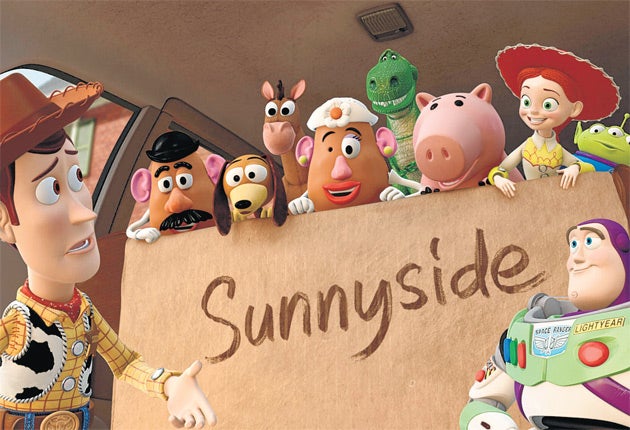Toy Story 3 (U)
Let's hear it for the toys

Your support helps us to tell the story
This election is still a dead heat, according to most polls. In a fight with such wafer-thin margins, we need reporters on the ground talking to the people Trump and Harris are courting. Your support allows us to keep sending journalists to the story.
The Independent is trusted by 27 million Americans from across the entire political spectrum every month. Unlike many other quality news outlets, we choose not to lock you out of our reporting and analysis with paywalls. But quality journalism must still be paid for.
Help us keep bring these critical stories to light. Your support makes all the difference.
Is Pixar the saviour of family entertainment? It's hard to know how else to describe a studio that consistently knocks all competitors into a cocked stetson. It takes a kind of genius to combine a children's movie for grown-ups and a grown-up's movie for children in one glittering digimated package, yet the folks at Pixar have done it time and again. If they had only made Finding Nemo, The Incredibles, Wall• E, and Up it would be a staggering achievement. But that doesn't take account of its star player, Toy Story, spearhead and prince among movies, returning here for a third and probably final go-round. It is the film of this summer – of any summer.
Its U certificate belies the fact that Toy Story 3 is a meditation on ageing, impermanence and mortality. Yet it's also a dizzyingly funny romp that honours and extends the glorious invention of the first two films. With more than a decade gone since Toy Story 2, the filmmakers (John Lasseter, Andrew Stanton and the director Lee Unkrich) have pushed cowboy Woody, space ranger Buzz and the rest of the toys towards a crisis of transition: their owner, Andy, has outgrown them, and is now about to leave home for college. Will they be packed off to the limbo of the attic or, worse, flung into a black bin bag for the trash collection? (The toy soldiers have already scarpered). "Oh, this is just sad," says Mr Potato Head, and you'd have to agree. After various misadventures the toys fetch up in Sunnyside, a children's day-care centre, where a huggy bear named Lotso (voiced by Ned Beatty) is the apparently benign steward: "No owners means no heartbreak," he says, though he omits to mention the marauding toddlers that will kick, chew and drool over them. Too late do they twig that they're locked up in a place of "ruin and despair" – the toytown equivalent of Alcatraz.
The scriptwriter Michael Arndt (who wrote Little Miss Sunshine) gets full value from the old favourites, turning Buzz at one stage back into a deluded martinet and later into a flamenco-dancing Latin lothario with the hots for cowgirl Jessie. But he also has fun with new characters such as preening clothes-horse Ken (voiced by Michael Keaton) and his Barbie; Lotso's prison enforcer Big Baby (with a sinister eye droop); a Monkey watchguard with clashing cymbals and a hedgehog, Mr Pricklepants, who fancies himself a thespian. The drollery is in the detail, which sometimes comes so fast it's gone before you have time to chortle. I loved the moment Buzz, anticipating the stampede of terrible tots, smoothly flips up his spaceman visor for protection. And I sniggered at the scene in which Woody, trapped in a toilet cubicle, puts a square of bog roll on the seat before he climbs on to it and makes good his escape through the window. Hardly a sequence goes by without something that delights, or exhilarates, or amuses.
Or indeed provokes to wistfulness. The first and second Toy Story movies dealt with setbacks that could be put right. As the producer John Lasseter says, "When you're broken, you can be fixed; when you're lost, you can be found; when you're stolen, you can be recovered. But there's no way to fix being outgrown by the child." What the film does so beautifully is to twist the existential crisis of a toy into a reckoning of our younger selves. It understands how we attach fond significance to those things that have been mute companions – and witnesses – through the years, and have measured our lost time. It is a poignancy that gathers such force by the end that my eyes, already moistened at the edges, started brimming helplessly. Discarding my 3-D specs I fled the cinema via the echoing stairwell of the emergency exit, hoping to hide my face away. "You're a grown man crying over a film about toys," I chided myself. But oh, what a film; what toys.
Have you seen Toy Story 3? Our Culture Club is looking for short reader reviews for the paper - leave your thoughts below
Join our commenting forum
Join thought-provoking conversations, follow other Independent readers and see their replies
Comments